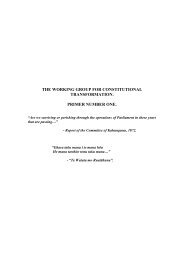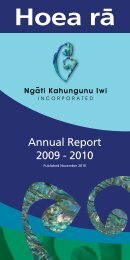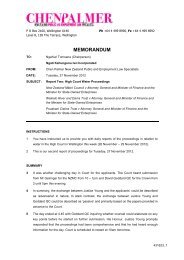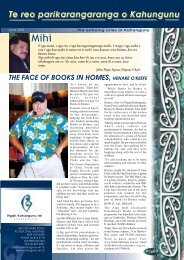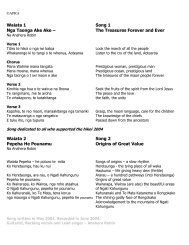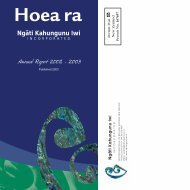StRAtEGic PlAn FoR ThE REVitAlisAtion OF TE REo O NGÃti ...
StRAtEGic PlAn FoR ThE REVitAlisAtion OF TE REo O NGÃti ...
StRAtEGic PlAn FoR ThE REVitAlisAtion OF TE REo O NGÃti ...
You also want an ePaper? Increase the reach of your titles
YUMPU automatically turns print PDFs into web optimized ePapers that Google loves.
ContentsHe Mihimihi | 3Introduction | 4Te Wai Ahupuke – The Vision | 8Te Wā Kaikino Nei - The Current Situation | 10Language Revitalisation Dimensions | 15Strategic Principles | 16Goal Summary | 17Te Tōpuni Tauwhainga - The Strategy | 18Overview Of Strategic Direction | 19Goals And Outcomes | 21Pathways For Future Project Development | 33References | 35Bibliography | 35He Mahere Rautaki Hai Haumanu I Te Reo O NgĀti Kahungunu 2006 - 2027 | 401
IntroductionKO TAKITIMU <strong>TE</strong> WAKAKO TAMA<strong>TE</strong>A ARIKI NUI <strong>TE</strong> PŌTIATIAKO RUAWHARO <strong>TE</strong> TOHUNGAKO KAHUNGUNU <strong>TE</strong> IWIHISTORICAL BACKGROUNDWhen the Takitimu waka arrived from Hawaiki it travelled first along partsof the west coast before slowly navigating the east coast. It finally arrivedand remained at Te Wai Pounamau. There are many events that have beenrecorded and handed down about the voyage along the east coast some ofwhich arePāpāwai village, near Greytown in the Kahungunu district of Wairarapa, was an importanttribal site in the late 19th century. It was here in the 1860s that the eminent tohunga TeMātorohanga and two other tohunga, Nēpia Pōhūhū and Okawhare taught the knowledge andancient lores of Ngāti Kahungunu in the Whare Wānanga.These ancient teachings were recorded by the scribe Hoani Te Whatahoro Jury and latertranslated by the ethnologist S. Percy Smith in the book The lore of the whare wānanga.The Māori parliament, known as Te Kotahitanga, met at Waipatu marae in Hastings in 1892and 1893 and at Pāpāwai marae in 1897.• Whare Wānanga were established at Waimapu in Tauranga, Nukutaurua and Te Māhia• The anchor of the waka, Taupunga was left offshore at Waimārama after which theWhare Puni is named• The daughter of Ruawharo, Ohinemuhu, was left at Porangahau and a red rockremains as a sign of whether or not kai moana is plentiful.Kahungunu was born at the Tinotino pā in Ōrongotea (later named Kaitāia). His fathersubsequently moved to the Tauranga area, where Kahungunu grew to adulthood. Tall andhandsome, he was renowned for his charismatic leadership. He supervised the planning andbuilding of entire villages, the irrigation and drainage of cultivations, the gathering of food,and the arts of carving, tattooing, weaving and canoe making.In the 1800s and early 1900’s Kahungunu reo flourished throughout the vast Ngāti Kahungunutribal rohe. For a number of reasons it has declined rapidly and while there have been a numberof positive initiatives to improve the situation such as the work of Canon Wi Huata, the successof Radio Kahungunu and the many education providers who offer te reo courses, Kahungunureo will be lost forever if a concerted effort is not made now to revitalise it.The future shock impact was realised when Tohara Mohi visited the Turnbull Library toexamine Te Kawa o Ngati Kahungunu which included the arts and te reo. Tohara found a hugebank of information which had been lost over the decades. From that emerged the “Kahungunu- ka moe ka puta exhibitions based on hundreds of photographs of Kahungunu tipuna takenin the late 19th century. Tohara reflected this event with the words “in finding our iwitangathe arts are the soul of the iwi and te reo is the soul of the arts” which is a phrase that we haveadopted in the revitalisation of the arts and te reo o Kahungunu.4
NGATI KAHUNGUNU STRA<strong>TE</strong>GIC ALIGNMENTIn 2002, Ngāti Kahungunu Iwi Incorporated undertook a marae hikoi,visiting more than 50 marae to develop the Ngāti Kahungunu StrategicVision 2026. The vision, ki te whai ao, ki te ao marama, reflects ourcollective desire, as Ngāti Kahungunu, “To achieve excellence in the highestorder and to be in constant pursuit of excellence in all areas of our lives” .The Ngāti Kahungunu Iwi Incorporated mission to achieve this is “To enhance the mana andwellbeing of Ngāti Kahungunu” through the empowerment of whānau, hapū and Taiwhenuaand to determine and achieve success according to our respective and collective aspirations.The primary principle that underpins the Ngāti Kahungunu Iwi Incorporated strategic visionis whānaungatanga, Te Tuhonohono o Kahungunu, the tapestry of whakapapa that makes uswho we are today.and support programmes and projects that preserve, extend and promote cultural knowledgeand practice for and between whānau through wānanga, exhibitions and festivals.The Matauranga plan 2003-2005, identifies the need for increased Kahungunu reo resources,culturally appropriate curriculum, services, programmes and support. We set a goal for te reoto be available in all schools in Kahungunu and an in-homes programme to encourage andsupport intergenerational transmission.Making our mark as Kahungunu is reflected throughout our strategic vision. Explicitexamples of this are:• Establishing Kahungunu identity as a nation• Our people as International Iwi ambassadors• The alignment of government boundaries to reflect our tribal boundaries• The protection of our cultural landmarks• Building our cultural strength through Takitimu festivals• The establishment of a whare wananga• Ensuring our history and reo is taught in all schools• Creating and showcasing our cultural heritage in waiata, whakaaro, sports, film andprint media• Relearning our rongoa• Creating more regional, national and international awareness of who we are as a nationthrough signposting, speaking our own reo, and establishing our own parliament.In 2005, we reaffirmed our goal to reclaim and reflect our cultural skills and strength. Acentral feature of our whānau education development is the acquisition and transmission ofcultural skills. Our iwi Hauora plan 2003-2005 highlights our reo and tikanga as central to ourwell being and the affirmation of our identity as Kahungunu.Operational links to our language, whānaungatanga and cultural goals are the fundingof community events that promote Kahungunutanga such as Matariki and substantiatedthrough Waitangi day celebrations. Ngati Kahungunu Iwi Incorporated also highlights thispriority through its involvement in the planning phase of the Kahungunu cultural centre,the development of Kahungunu cultural standards for schools and contract arrangementsfor Community Based Language Initiatives. In addition, the establishment of a KahungunuTaumata, recognizing the living Kahungunutanga expertise and the Kahungunu KahuiKaumatua goal to address Kahungunu paepae capacity and capability, represent significantinvestment by Ngati Kahungunu in our cultural heritage and future.Cultural excellence is a priority for Ngāti Kahungunu whānau and hapū. One of the keystrategic goals for Ngāti Kahungunu Iwi Incorporated is to establish a Cultural Centre for theadvancement and expression of Kahungunutanga. This centre will become a catalyst to developThe Community Based Language Initiative programme (funded by the Ministry of Education)is a significant, but short term resource to assist our larger plans of strengthening thedevelopment of language and cultural capacity.5
The Current SituationThroughout the rohe of Kahungunu there are approximately 1300 tamarikiattending Kohanga Reo, 600 students attending Kura Kaupapa and WhareKura with 7 major tertiary institutions teaching te reo. Statistics show that forvarious reasons, approximately 60% of Kohanga Reo tamariki do not continueon to Kura Kaupapa Māori.While there are a number of tertiary Institutions teaching Te Reo Māori, less than 10% of theirstudents are conversing regularly in Māori at home and less than 20% of kohanga parents arecommitted to speaking te reo to their tamariki at home.A major concern highlighted in our literature review is that our kaumātua and tamariki livingat home together are not communicating in te reo MāoriThe health of te reo o Ngāti Kahungunu is compromised and despite current governmentinitiatives, it remains under serious threat of dying as a spoken language within the next twoto three generations.6
Kahungunu Tikanga & Reo Advisory CommitteeAwhina WaakaDr. Rangimarie Turuki Rose PereEnoka MunroHaami MoekeLiz HunkinWiremu PrenticeHeke HuataHineihaea MurphyHiria TūmoanaLee SmithBasil KeaneTere MunroBenita Tahuri7
Te Wai Ahupuke – The Vision“Ngā Tukemata Rau Whakaoho”“Capturing and realizing Kahungunu potential”“By the year 2027 Kahungunu Reo will be the preferred means ofcommunication in all domains for the majority of Kahungunu iwi”The Ngāti Kahungunu Strategic Vision expresses the need for our people to,“be conversant in Kahungunu reo”. This Strategic Plan extends the vision toinclude whānau, hapū and all domains in the community. Our people willhave an increased awareness of issues relating to te reo Māori and researching,reconstructing, learning and using Kahungunu reo. This requires theestablishment and ongoing development of collaborative relationships withother stakeholders.Ngā Tukemata is a well known Kahungunu expression and the vision here is one of “hundredsof Kahungunu facial expressions having been awoken and delighted at being able tospeak and hear Kahungunu reo at any time and in all places”When we hongi and our tukemata touch we are communicating our oneness with oneanother and a reawakening takes place as we link in with each other –Tīhei Mauri Ora!8
Focus of StrategyThe focus of this strategy for the period 2006 - 2009 is:» To strengthen the Kahungunu paepae» To create and improve learning opportunities for whānau and hapū» To encourage an awareness of issues relating to Kahungunu reo and tikanga» To increase the amount of reo being spoken in the homes and other domains» To research, reconstruct Kahungunu Reo and provide resources for distribution» To develop sustainable relationships with other stakeholders9
Te Wa Kaikino Nei - The Current Situation“E Puta Rānei Tō Reo, E Tama, I Te Wā Kakino Nei ”“My son, will the language of our ancestors survive in these crucial times”A Summary of the Environmental ScanCensus 2001 shows:» Ngāti Kahungunu has the third largest population of any iwi, and thesecond largest rohe.» 38% of Ngāti Kahungunu are under 15, while only 3% are 65 and over.The median age is 20.9 years.» 64% of Ngāti Kahungunu live outside the tribal area. 32% live in theHawkes Bay region, 16% in Wellington and 12% in Auckland» 86% of Ngāti Kahungunu live in urban areas while those aged 65 +make up the majority of the rural population.» 54% of Ngāti Kahungunu members are female» 28% of Ngāti Kahungunu members are able to have a basic conversationin te reo Māori.10
Hau te kura ~ the kura of renownThese options will be used to promote:In this phrase, the kura is known far and wide. This is what needs to happen withKahungunu reo, that it once again becomes known far and wide by iwi members.Options to do this include:» Website development» Ngāti Kahungunu already have a website. Initially, at least, this could be used tomake this information available. This is an ideal medium for those Kahungunumembers not living in Aotearoa.» Books, CD-roms» Mōteatea, recordings of kaumātua and instructional resources can be provided ina simple book/CD format.» Strategies for language use, e.g. practical tips on how people can increase theiruse of te reo; how they can get support or establish their own support networks;how they can make te reo Māori a part of their daily lives.» Language of the home, of children, of parents and of other domains – givingpractical, relevant examples of how to say everyday things in different domains» Practical examples of Te Reo o Kahungunu for everyday phrases» Key messages about language, language issues and motivational type messagesto change attitudes and gain buy in at a very local level, i.e. from individuals andfamilies.» Te Reo Irirangi o Kahungunu.» Radio Kahungunu has taken a significant role in revitalising Kahungunu. It isvital therefore that Ngāti Kahungunu Iwi Incorporated secures the support ofKahungunu radio in promoting Kahungunu reo.» Hoea Rā - Iwi Newsletter» The newsletter can be used in a number of ways e.g. promoting various te reocourses available providing for the need of intergenerational transmission bypromoting Kahungunu reo.13
Tēnei te tira hōu ~ here is the new groupWhanake tekura i raro i Awarua ~ the kura which arise up from AwaruaIncreasingly, Kahungunu speakers are second language learners trying to acquire tereo. Ngāti Kahungunu should not focus on teaching the language but should promoteopportunities for learning by:» Promoting existing courses.» Promoting any package which identifies Kahungunu reo to the institutions andgroups who teach Māori within the Kahungunu rohe.This refers to the cultural treasures from Hawaiki. Te reo is one of those treasures so let thereo rise up again and grow. That is, let it be used more often, in more places.Ngā Tairo a Kupe ~ the obstructions of KupeNgāti Kahungunu has a number of difficulties to overcome in promoting Kahungunu reo.e.g.the lack of statistics which accurately identify the health of te reo within the Kahungunuregion.» Promoting immersion courses and Kura Reo throughout the year.» Promoting other learning options such as Kōrero Mai, on Māori Television, andvia the website www.koreroMāori.co.nz.Also Ngāti Kahungunu is one of the largest iwi, both in terms of population and the size ofits rohe which means that language revitalisation will be more difficult for Ngāti Kahungunuthan most other iwi. 14
Language Revitalisation DimensionsIn summary, the issues and needs can now be categorised in line with the four dimensions oflanguage restoration identified by Joshua Fishman, an eminent socio-linguistic writer.Whakaoho ~ Status, Critical AwarenessWhakamahi ~ Whānau Use» The awakening of our people» Intergenerational transmission» Promotion of language issues and strategies for language use» Language leads» Promotion and marketing of Kahungunu reo» Whānau use in homes and other domainsWhakamana ~ Corpus, Paepae And ResearchA fifth critical dimension that Ngāti Kahungunu has identified is:» Research and reconstruction of Kahungunu reo» Quality of reo on the paepaeWhakawhānaungatanga~ Building RelationshipsWhakaako ~ Acquisition, Knowledge» Course promotion» Promoting Kahungunu reo to institutions» Development and delivery of whānau reo and tikanga programmes» Whānau, hapū, iwi» Local, regional and national groups and institutions» Capacity buildingThis addition reflects our roles and responsibilities as a kinship group, seeking to revitalisetribal language and traditions, rather than a national language.15» Training of community leads
Strategic PrinciplesFrom the Strategic Vision Statement the following principles for our language and culturalrevitalisation have been determined:TūhonohonoTe Kotahitanga1. Participation – A focus on whānau and community, rather than iwi led participation. Astrategy for all whānau and hapu within Kahungunu.2. Whānau centred – Recognizing that revitalisation of our language and culture acrossgenerations and within families is the key.5. Sustainability – Te reo and tikanga outcomes pertaining to this plan must be sustainablebeyond government funding and the leadership and direction of any individual, group ororganization.6. Quality – To ensure that the quality of Kahungunu reo and tikanga is in place.Te Hononga MareikuraTe Tiriti O Waitangi3. Influence – Recognizing that revitalising our language and cultural traditions willrequire significant influence over the dominant language and culture – English/mainstream.4. Integration – The revitalisation of our language and culture as Ngati Kahungunu willrequire a range of strategies and approaches that will be integrated with our long andmedium term goals.7. Protection – The intellectual property rights and responsibilities of whānau, marae, hapuand iwi are paramount.8. Partnership – To establish equitable and collaborative relationships with stakeholderswho will support the revitalisation of Kahungunu reo and tikanga.16
Goal SummaryShort Term 1-5 yearsMedium Term 5-15 yearsLongTerm 15-25 yearsWhakaohoEncourage an awareness of the issuesaffecting Kahungunu reo.Promote Kahungunu events and activities.Continue encouraging an awarenessof any remaining issues. Sustain andincrease number of activities and events.Ngāti Kahungunu will be regularlyexpressing and celebrating ourKahungunu reo, culture and identity.WhakamanaIdentify and revitalise unique Kahungunu reoand tikanga.Kahungunu corpus of te reo resources areaccessible by whānau, hapū, marae, iwi,Kahungunu whānau, hapū, iwi andmarae are confident in Kahungunu reoCreate and distribute Kahungunu reoteachers, performers, artists.and tikanga.resources.Strengthen paepae.WhakaakoCreate and improve Te reo learningopportunities and experiences.Sustainable learning opportunities. A largerpool of quality Kahungunu reo teachersKahungunu whānau are usingKahungunu reo. Kahungunu teachersare teaching Kahungunu reo.WhakamahiImprove and increase the quality and quantityof Kahungunu reo.Increase and sustain te reo projects, programsand events such as He Hoa Kōrero.The majority of Kahungunu homes/domains are using Kahungunu reo.WhakawhānaungatangaEncourage and establish positive relationshipswith whānau, hapū, iwi and all stakeholders.By the year 2020 the positive impact ofrelationships with all stakeholders will beevident.Sustainable relationships with allstakeholders will be in place to supportour reo and tikanga.17
Te Topuni Tau Whainga - The StrategyWhakaoho | Whakamana | Whakaako | Whakamahi | Whakawhanaungatanga“Kia wetea mai ko te tōpuni tauwhaingaHei kahu mōhou ki te whakarewanga taua”The strategy for revitalising Kahungunu reo and tikanga will be unravelled by the use of the5 strands of the tōpuni tauwhainga – whakaoho, whakamana, whakaako, whakamahi andwhakawhanaungatanga.While Fishman provides us with these strands of corpus, critical awareness, status, use andacquisition, the consultation with iwi and the input of the Iwi Advisory Group enhances this withthe binding element of whakawhanaungatanga.“Nāhana te kahu i whatu, mā te iwi e tānikoniko”18
Overview Of Strategic Direction1. Whakaoho I Te Iwi Ki Te Reo2. Whakamana I Te Pae Tapu O Huaki Pouria) The promotion and marketing of te reo through print media and promotional materialb) The utilisation of local and national radio, television, networks and the internet.c) Organising and promoting events, activities, festivals and wānanga that promoteKahungunu reo and revitalisation issues.Promotion and marketing will include language issues, key messages and strategies forlanguage use.“Kōrero Māori, kia kaha ake”a) Preservation and research into Kahungunu reo, tikanga and mātauranga needs to occur toensure that this knowledge is not lost.b) Opportunities created for Kahungunu speakers and kaikaranga to access this informationand specialised training opportunities to ensure that this mātauranga is passed on.c) Implementation of a succession strategy that ensures our knowledge continues to bepassed on to future generations of Kahungunu speakers.It is essential that whanau, marae and hapū in each taiwhenua are awakened and supported toset their own goals and plans. This is likely to require identifying a key/lead person or rooputhat will promote this initiative and initiate action for other marae and groups.19
3. Whakamana I Te Reo O Kahungunu5. Whakamahi I Te Reoa) Wānanga of key Kahungunu reo speakers build a research for Kahungunu reo.a) Encourage and promote the use of Kahungunu reo in the homes.b) Kahungunu reo will be researched, analysed and documented as audio, visual andprinted resources to be distributed4. Whakaako I Te Reob) Increase the number of domains that use Kahungunu reo.c) Support current environments where Kahungunu reo is spoken and heard. Thiswill include extending current initiatives and good models of use and creating newinitiatives.d) Remove barriers that prevent or limit the use of te reoa) Strategic relationships will be developed with the reo providers in the Kahungunu rohe, toensure there are synergies between the Kahungunu reo vision and current provision of reoservices in the Kahungunu rohe. This will enable Kahungunu to have representation anda voice within these institutions as well as input into curriculum and service delivery.6. Whakawhanaungatangab) Supporting the training and up skilling of Kahungunu teachers.a) Formal relationships are established and developed with education providers, businessand community organisations and other iwi - Rangitane and Rongomaiwahineb) The other important stakeholder relationships will be between native, fluent, moderatespeakers and new and second language speaking parents, children and kaumātua.20
Goals and OutcomesIn 2027 Kahungunu will stand strong and proud in our Kahungunutanga,reo and tikanga and there will be ample opportunities and resourcesavailable to us to access, express, exhibit and celebrate all elements ofour culture and identity as Ngati Kahungunu in local, national andinternational forums21
O OWmNWhakamanaWhakamana –The corpus of our language and culture – preserving, protecting and promotingour unique kupu, kīwaha, reo and kawa – Kahungunu reo and tikangaWhakaoho - Developing a communications strategy/plan that provides factual informationregarding Kahungunu reo/tikanga to encourage kaumātua to be part of helping to preserveour reo/tikanga by participating in a digitization projectWhakawhanaungatanga - Facilitating relationships to lead local projects to collect and collaterelevant stories, kupu, kiwaha, tikanga, history, whakapapa, events, marae informationfrom our living taonga, our kaumatua.Whakaako – Developing learning resources to revive our Kahungunutanga, supportinglearning opportunities that contribute to developing and sharing Kahungunutanga» By 2009 Digitization projects to preserve, protect and promote Kahungunutanga,focusing on our living taonga will be completed within each taiwhenua rohe.» By 2013 – Kahungunu resources will be used by whānau and education institutions asthe local curriculum.» By 2020 – Our reo, history and whakapapa from the past 1000 years will be preserved.Whakamahi - Organising and promoting wananga, events, resources and programmes thatshowcase our Kahungunutanga.25
EOWhakaakoWAOLIWhakaako –Improving and creating whānau learning opportunities and experiences thatempower the whole whānau and create speaking opportunities and more interaction in te reo– conversational reo through to te reo used by native speakers – removing and overcomingbarriers to learning – time, money, transport.Whakaoho – Promotion of learning opportunities to revitalise our KahungunutangaWhakamana – Learning opportunities revive our corpus and unique tikanga, kupu, kīwahaetc as Kahungunu.Whanaungatanga – Creating more opportunities for whānau to take control of their learningthrough greater informal opportunities for interfamilial and intergenerational transmissionand learningWhakamahi – Engagement of whānau, hapū and iwi in learning opportunities that havespeaking and listening as a focus, while not ignoring the need for reading and writing skills.Creating or adapting ‘learning’ programmes that meet the need of the whole whānau, ratherthan the adult learner or the teacher.» By 2009 – New whānau programmes of learning and teaching Kahungunutanga willbe established in each taiwhenua rohe, including the reo in homes.» By 2013 – Resources used by all reo providers in the Kahungunu rohe will includeKahungunutanga. Takitimu history will be taught in all schools.» By 2020 – Kahungunu distance learning programmes will be available for all whānauthroughout the country and the world.» By 2027 – Through concentrated effort and celebration Ngati Kahungunu traditionaland contemporary culture and language will survive and achieve national recognition.27
ORAWhakamahiWAISWhakamahi– Use it or lose it! Just do it! Kimihia he hoa kōrero. It is being used in homes,families and communities, for praising, reprimanding, gossiping, shopping, buying petrol, atlocal and national events and ever increasing domainsWhakaoho – Overcoming our fears to use the reo we have with our whānau and friendsWhakamana – Using Kahungunu reo and pūrakau to give life to being Kahungunu» By 2009 – Language surveys and research will show an increase in the number ofwhānau using te reo» By 2013 – Census and language surveys will show that there is an increase in thenumber of Ngāti KahungunuWhanaungatanga – Creating supportive relationships within our whānau to improve our useof reo and tikanga Kahungunu.» By 2020 – Census and language surveys will show that there is an increase in thenumber of Ngāti Kahungunu people using te reoWhakaako – Growing our reo as whānau, hapu and iwi.» By 2027 – Our people will be bilingual in te reo o Ngāti Kahungunu and English.29
WNungtangWhakawhanaungatangaWhakawhanaungatanga – Awakening and mobilising our people, systems and structures tosupport/live our reo and tikanga goals. The development and mobilization of communities,other groups and businesses to help us realize our goals.» By 2009 – Key groups and people will be identified and accessible to promote andlead our reo and tikanga revitalisation within all Taiwhenua rohe.Whakaoho – Knowing who in our whānau, community, country, world can help us advanceour dreams and aspirations for the revitalisation of Kahungunutanga.Whakamana – Understanding the importance of our shared kinship to our tipuna andeponymous ancestor, Kahungunu. Retaining our reo and tikanga in ways that epitomize ourrelationships as an iwi/ kinship group, unique and distinct from all others.Whakaako – Learning more about who we are and our relationships as Kahungunu, withinour communities and with those agencies who can support us (TPK, Taurawhiri). Sharingthis information with others.Whakamahi – Working together as a critical mass of whānau, hapu and iwi to develop andstrengthen the relationships that will support us to revitalise our language and culture.» By 2013 – The sanctity and strength of our Whakapapa will be known and willstrengthen our relationships as families and across generations.» By 2020 – The relearning and practice of our tikanga will be accessible to all whānau.» By 2027 – Marae and papakainga will flourish and emanate Kahungunutanga.31
Pathways For Future Project DevelopmentOur strategy acknowledges the need for projects and programmes that are innovative,relevant and effective. This means that we will need to continuously monitor and review:Project Inform≈invite≈inspireWhakaohoWhakamana1. Our target groups2. Whether or not projects are meeting their needs. If so, how, and if not, why not?3. If this is the best way to achieve the outcomes and goals?4. A framework or criteria that supports innovation and sustainabilityWhakaakoWhakamahiWhakawhanaungatangaWhat are the key messages that address attitudes? What information are we providing aboutte reo and what kind of language skills are we promoting?One suggestion is to use an ‘inform, invite, inspire’ approach across the strandsWho do we need to be sharing our messages with? Who are we inviting and does the projectinvite them to take action? How are we inviting them and where are we inviting them to?How will this project inspire our people and the wider community culturally, intellectuallyand spiritually?33
References26 Consultation hui held.BibliographyWebsitesKahungunu Kohanga Reo Wānanga, Te Wānanga o Raukawa,Kura Kaupapa and Whare Kura o Tamaki-nui-a-Rua, Staff of Regional Te Puni Kōkiri andKahungunu Mātauranga Board, Te Wānanga o Awanuiarangi, Central Hawke’s Bay CollegeMāori Teachers, Te Wānanga o Aotearoa, Te Aute College, EIT Hawke’s Bay, Taradale,Massey University, Te Ataarangi Whānau, Wairarapa Te Reo and Health Providers,Tamatea Taiwhenua, Heretaunga Taiwhenua, Ngāti Kahungunu Iwi Incorporated Hui a Tau,Kirikiriroa Taurahere, Whanganui-a-Orotu and Heretaunga Reo Students, Wairoa Providersand Kaumātua, Teachers and Kaumātua from all Taiwhenua and Taura Here at EIT Hawke’sBay, Whanganui-a Orotu Taiwhenua, Te Upoko o Te Ika Taurahere, Tamaki Makaurau TauraHere, Wairoa Taiwhenua, Te Ataarangi Students and Staff, Tānenuiārangi Marae, WairarapaTaiwhenuawww.bwrdd-yr-iaith.org.uk (Welsh Language Board)www.kotahimanokaika.com (Ngāi Tahu)www.jan.ucc.nau.edu (Language revitalisation website)www.stats.govt.nz (Statistics New Zealand)www.tetaurawhiri.govt.nz (Te Taura Whiri i te Reo Māori)www.tpk.govt.nz (Te Puni Kōkiri)www.taranakireo.co.nz (Te Reo-o-Taranaki)www.teara.govt.nz (NZ Encyclopedia)www.kahungunu.iwi.nz (Ngāti Kahungunu Iwi Incorporated)35
PublicationsTe Puni Kōkiri. 2002b. The Use of Māori in the Family. Te Puni Kōkiri. Wellington.Benton, R. & Benton N., ‘RLS in Aotearoa/New Zealand 1989-1999’ in Fishman, J. A.(ed.) Reversing Language Shift. Multilingual Matters. Clevedon.Te Puni Kōkiri. 2003. Speakers of Māori in the Mäori Population. Te Puni Kōkiri.Wellington.Biggs, B. 1989. ‘Towards the Study of Māori Dialects’ in Harlow, R.B. & R. Hooper(eds.) in VICAL 1: Oceanic languages. Papers from the Fifth International Conference onAustronesian Linguistics. Auckland: New Zealand Linguistic Society. Pp. 61-75.Te Puni Kōkiri, 2002. The Health of the Māori Language in Te Taihauuru. Wellington:Te Puni Kōkiri, Ministry of Māori Development.Chrisp, S. 1997a. Diglossia: A Theoretical Framework for the Revitalisation of the MāoriLanguage. He Pukenga Korero 2(2):35–42.Chrisp, S. 1997. Home and Community Language Development, in New Zealand Studies inApplied Linguistics (3):1-20.Fishman, J. 1991. Reversing Language Shift. Multilingual Matters. Clevedon.Fishman, J. 2000. Can Threatened Languages be Saved? Multilingual Matters. Clevedon.Te Puni Kōkiri, 2002. The Health of the Māori Language in Te Tairāwhiti. Wellington:Te Puni Kōkiri, Ministry of Māori Development.Te Puni Kōkiri, 2003. The Health of the Māori Language in Te Upoko o te Ika me Te Tauihu,Wellington: Te Puni Kōkiri, Ministry of Māori Development.Te Puni Kōkiri. 2004. Te Reo Māori i te Hapori – The Māori Language in the Community.Te Puni Kōkiri. Wellington.Francois Grin & Francois Vailancourt Language Revitalisation Policy, An Analytical Survey.Treasury Working Paper 98/6Hond, R., and Sundgren, H. (2003) Towards a Strategic Development Plan for TaranakiMāori Language, Report 1, Te Reo-o-Taranaki Charitable Trust, Taranaki.Te Rito, J. S. 1999. Revitalizing the Māori Language – Some Lessons From Abroad,A Report for the Winston Churchill Memorial Trust. Unpublished Report.Tomlins Jahnke, H. Ko te Amorangi ki mua... Ngāti Kahungunu Iwi Mātauranga Plan 2003-2005 Hastings, VKA Advertising, 2003.Kahui Tautoko, 2005. Healing our Spirits. Ngāti Kahungunu Iwi Health Plan. Kahui Tautoko.WellingtonTe Puni Kōkiri. 2002a. The Health of the Mäori Language in 2001. Te Puni Kōkiri.Wellington.Tomoana, Joy. 2005. Ngāti Kahungunu Education ProfileWaite, J. 1992. Aoteareo: Speaking for Ourselves. Learning Media. Wellington.36
AcknowledgementsGlossaryCharisma Rangapuna – Strategic Plan assistanceCBLI – Community Based Language InitiativesPiri SciaScia – Kaupapa KahungunuDoug Ferris, Bruce Wakefield, Sally Rye, Roseanne Jones, Hawkes Bay Today – photosBasil Keane and Sara Reo – Literature ReviewNgahiwi Tomoana – Philosophical and historical contentKahungunu Mātauranga Board – Quality assuranceNgāti Kahungunu Iwi Incorporated Staff and Board, project support and strategic sign offIntergenerational transmission - kaumātua and rangatahi communicating in te reo with eachotherInterfamilial transmission – families communicating in te reo with each otherDomains – the different places where te reo Māori could and should be spokenAcquisition – acquiring and learning te reoCorpus – an iwi dialect or how a threatened language acquires new vocabulary for newphenomenaTūranganui-a-kiwa, Raukawa, Tauranga Moana, Whanganui CBLI workers -WhanaungatangaTe Tau Ihu, Ministry of Education - Project fundingMateroa Haenga, Lee Smith and Te Manga Māori o Te Whare Takiura o Kahungunu - MāoritranslationStatus – the value people place on a threatened languageCritical awareness – the need for speakers of the threatened language to be aware of thethreatened state of te reo and the consequences if they don’t speak it to others in theirwhānauLanguage leads – people who will take responsibility within their whānau and communityto initiate opportunities for te reo to be used37
Images1. Wairoa River, pg 12. Te Pania, Ahuriri, pg 23. Te Reo and Tikanga Advisory Committee, pg 44. Tamatea Ariki Nui o Takitimu Waka traveling toWairoa, pg 55. Paora Winitana and Richmond School students,pg 76. Te Whakapono o Te Pou Herenga Waka KohangaReo, pg 137. Te Ataarangi, Wairoa, pg 148. Topuni touwhainga, Muriwhenua, pg 189. Whenuaroa whanau & Te Kura Kaupapa OWairarapa, pg 1910. Kahurangi, pg 2211. Hukarere, pg 2412. Nga Waka/Tamatea Arikinui, pg2613. Whanau Gillies, pg 2814. Whanau Whenuaroa, pg 3015. Whanau Nuku, pg 3216. Tararua, pg 3417. Carving Pg 39
Ma te reo o Ngati Kahungunu38



